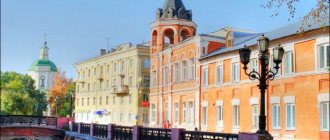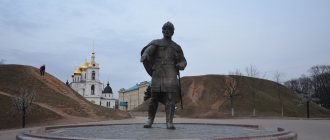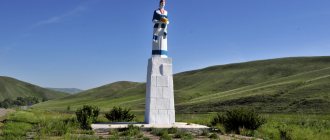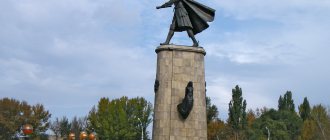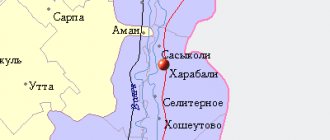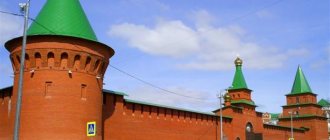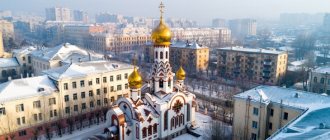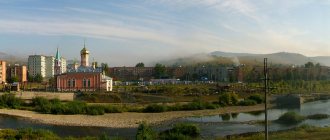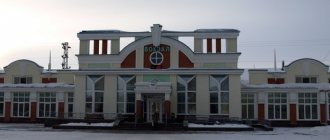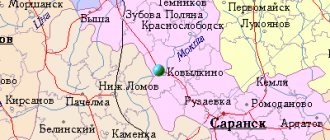- Reports and messages
- Miscellaneous
- Mytishchi city
Mytishchi is one of the cities in the Moscow region, located on the Yauza River.
The distance to the center of the capital from Mytishchi does not exceed 20 km in the northeast direction. The city's close proximity to Moscow makes it unusually attractive in the eyes of other residents. The city was first mentioned in the 1460s as Mytishche - the place where the city was washed. What is it? Myt is a special collection from merchants who went down the Yauza to Klyazma. Later, Moscow became the center of tax collection, since ships stopped sailing along the Yauza, but the name of the city remained.
Today, more than 200 thousand people live in Mytishchi, most of whom are employed in industry. The city primarily produces subway cars, trailers, and dump trucks. The electronics industry is also developed - the production of cables and devices. In Mytishchi there are many chemical enterprises producing synthetic resins, plastics and products made from them, cellulose insulation.
Mytishchi is also of great importance as a transport center. The city occupies an important position on the Moscow-Arkhangelsk railway.
There are many parks in the city. The floodplain areas of the Yauza rivers, as well as the central park of culture and recreation, have been improved. Within Mytishchi there is the Losiny Ostrov National Park - one of the very first national parks in Russia, in addition, the largest national park located within the city. Here you can watch birds on a special tower, as well as look at moose calves and feed them.
The city of Mytishchi also surprises with the splendor of its monuments. There are monuments dedicated to the victory in the Great Patriotic War: a monument to the partisan, pilot N.M. Raspopova and many others.
The city of Mytishchi is an important cultural, transport and industrial center of the Moscow region.
Option No. 2
A city in the North-Eastern Moscow region, located 20 kilometers from the center of the capital, on the banks of the Yauza, which is attractive for potential residents when choosing apartments. The area of the city is 40 square kilometers. In terms of population, it ranks 94th out of 1,115 cities in Russia.
The history of the city's name goes deep into antiquity. In the 17th century, on the territory of present-day Mytishchi there was a port of the then navigable Yauza, where merchants paid the “myt” tax for their goods. Subsequently, the word “myt” was transformed into the name of the city of Mytishchi. The city itself dates back to the first century AD, as evidenced by archaeological finds. Since 1925, Mytishchi ceased to be a working village and received the status of a city.
The city is green, with many parks, a landscaped embankment, and a population of 222 thousand. Residents and guests of the city have a unique opportunity to watch moose calves and feed them. You can do this in the huge Losiny Ostrov national park, which is located within the city.
The city has military-themed monuments, as well as a modern monument to Samovar. Fans of cultural recreation in Mytishchi should visit the Mytishchi Drama and Comedy Theater “Fest”. The Mytishchi Historical and Art Museum preserves the history and traditions of the region. Be sure to check out the Mytishchi art gallery, which has a large collection of paintings. For active recreation, you should choose the Mytishchi Arena Ice Palace for a visit.
Cultural monuments have been preserved in Mytishchi. The station building, built in 1911, is an architectural monument, two wooden dachas of merchants Ageev and Buyanov have the status of an architectural monument, as well as the Church of the Vladimir Icon of the Mother of God built in 1713 and the Church of the Annunciation in Taininsky, built in 1675.
Most of the population works in the industrial area of the city. Brand new subway cars are being produced from the assembly lines of local factories. The electronics and chemical industries are developed. Cables, synthetic resins, plastic products, sidewalks, and curbs are produced here. There is a wood processing plant. The Titan jewelry factory produces products from precious metals. The Znamya Truda knitting factory produces a wide selection of knitted products.
The city has several universities, a mechanical engineering college and a medical school.
Story
“Yauza Mytishche” was first mentioned in the spiritual letter of the monk of the Simonovsky Monastery Adrian Yarlyk, dated July 1460. “Mytishche” designated the place where “myt”, a duty for transporting goods, was once collected from merchants. The history of our region goes back centuries. The first inhabitants - tribes of Neolithic hunters and fishermen of the Lyalovo culture - appeared here back in the 4th millennium BC. e. In the Bronze Age (2nd millennium BC), cattle breeders and metallurgists of the Fatyanovo culture lived on the Mytishchi land, and in the Iron Age (1st millennium BC) they were replaced by tribes of the Dyakovo culture, who built fortified villages on river capes , were engaged in cattle breeding and agriculture, and mastered iron production. The Slavs - Vyatichi and Krivichi - came here at the end of the 1st millennium AD. e. In the area between the Ucha and Klyazma rivers there was a conventional border between these tribes; here was the zone of their mutual penetration. Mixed burial mounds with Vyatic and Krivik burials are known. In the ancient Russian era, the Mytishchi region was quite densely populated. Now there are 12 settlements and settlements known here from the 9th to the 13th centuries, one of which is located on the banks of the Yauza within the boundaries of the modern city of Mytishchi. The Slavs brought with them a developed culture of arable farming, raised livestock, and were well acquainted with various crafts - metallurgy, blacksmithing, pottery, carpentry, and jewelry.
In the 11th - 14th centuries, an important trade waterway passed through the Mytishchi land along the Yauza and Klyazma rivers. This path has existed since time immemorial, long before the existence of Moscow. At this place, where Mytishchi is located, there was a collection point for passing duties from people and ships, which had a common name - myt. From Yauza to Klyazma, merchant ships were dragged overland for about 7 - 8 kilometers. The name of the city is associated with this trade route. A diagram of the ancient portage is shown on one of the museum stands.
Within the boundaries of Mytishchi there is the ancient village of Taininskoye (formerly Toninskoye), known since the beginning of the 15th century, - the hereditary patrimony of the great Moscow princes and Russian sovereigns, which served as their country residence. Rich palace chambers and outbuildings were erected here. This village near Moscow was the favorite estate of Ivan the Terrible, one of the centers of the oprichnina. Tsar Alexei Mikhailovich often visited here on his way to the pilgrimage and the Trinity-Sergius Lavra, relaxing in a specially built “travel palace”. By his decree, in 1675 - 1677, a stone manor church of the Annunciation, unique in Russian architecture, was erected next to the palace. Elizaveta Petrovna and Catherine II loved to visit Taininsky. In 1749, on the site of more ancient buildings, a new wooden palace was built in the then fashionable “Chinese style”, new residential and utility buildings appeared, and the palace garden was re-laid. At the end of the 18th century, the estate was abandoned and gradually fell into disrepair. The great fire of 1824 completed its destruction.
The upper reaches of the Yauza River have long been famous for its spring water. It was from here that the construction of the first Moscow gravity water pipeline began in 1779. Construction lasted 25 years and was completed in 1804. The water pipeline was quite a complex engineering structure for that time. Water from 28 key wells flowed into a brick-lined gallery that stretched 19 miles to Moscow. The Rostokinsky aqueduct has survived to this day - in the place where the water pipeline gallery crossed the Yauza riverbed.
In the second half of the 19th century, industry began to develop rapidly in the Mytishchi region. Plants and factories were built mainly near the Northern Railway line, built in 1862. In 1897, the carriage building plant produced its first products, and in 1909, the first artificial silk factory in Russia, Viscose. Gradually, a large industrial center and railway junction developed in the area around the village of Bolshie Mytishchi.
In 1922, a “working garden city” was founded in the area of the villages of Druzhba, Tabachnik (Leonidovka district), etc. By 1926. The population exceeded 10 thousand people. In 1925, Mytishchi received city status. During the pre-war five-year plans, the appearance of the city changed. A new hospital building and a carriage factory club are being constructed, and a sculpture factory (now an art casting factory) is opening. The chemical industry began to develop on the basis of the Viscose factory.
From 1932 to 1937 The route of the Moscow Canal, the world's first energy canal, passed through the territory of the district. In 1932, the villages of Rupasovo, Sharapovo, the villages of Bolshaya Mytishchi, Taininskoye, and Zarechnaya Sloboda were included within the city limits; villages of Perlovsky, Taininsky, Leonidovka, Druzhba. There was a need to build new microdistricts, but the war prevented the implementation of these plans.
During the Great Patriotic War, residents of the city and region contributed to the overall victory over the enemy. 45 thousand of our fellow countrymen went to the front. Of these, more than 20 thousand did not return from the battlefields. All enterprises switched to the production of military products. 6 hospitals were deployed and a fighter battalion was formed. The “Mytishchi Collective Farmer” tank column and the “Moscow” air squadron were built at the expense of the region’s workers. Thousands of Mytishchi residents were awarded orders and medals, 22 were awarded the title of Hero of the Soviet Union, three became full holders of the Order of Glory. Among them are A. I. Egorov, A. I. Kadomtsev, N., P. Seleznev, M. I. Tolmachev, N. M. Raspopova, V. I. Karpenko, I. A. Korablin and others.
The modern history of the city is a further path of economic and cultural development. The health service includes more than 50 medical institutions. Moscow Research Institute of Hygiene named after. F. F. Erisman is the largest scientific center in the country. The institute has methodological and experimental laboratories and a clinic. Mytishchi is a city of students.
The Moscow University of Consumer Cooperatives in Perlovka trains specialists in market economics for the cooperative system and other sectors of the national economy. Its graduates are able to work in commercial structures, stock exchanges, tax inspectorates, customs services, etc. The university includes a cooperative international training center. The Moscow State Forest University in the village of Stroitel is recognized as a basic university for forestry education and trains specialists in 11 specialties. Interesting research work is being carried out within the university. The Moscow Pedagogical University and a branch of the Moscow State University of Civil Engineering are recruiting students. Young people can receive secondary specialized education at the Mytishchi mechanical engineering and cooperative technical schools, at a higher vocational school - a technical lyceum and a medical school.
The new Palace of Culture became a real decoration of Mytishchi. People of all ages come here. Numerous clubs and interest clubs are located on an area of about 8 thousand square meters. m. The most spacious hall in the Moscow region is ready to accommodate up to a thousand spectators.
The Mytishchi shooting range “Dynamo” is widely known in the sports world, where international competitions in bullet and skeet shooting are held. The shooting complex meets the highest international standards. The area is rich in forests and reservoirs, which creates unique conditions for recreation and tourism. There are numerous boarding houses, sanatoriums and dispensaries in the region. Losiny Island is a famous reserve in the upper reaches of the Yauza, known since 1406. In 1840, it was here that the first forest management in Russia was carried out. Today it is a State Natural National Park with an area of more than 100 sq km - a unique landscape in central Russia.
Popular message topics
- The Work of Ray Bradbury
Ray Douglas Bradbury (1920-2012) is an outstanding American science fiction writer who wrote many interesting books, including the well-known dystopia “Fahrenheit 451,” which brought the writer - North America
North America is a continent washed by the waters of the Atlantic, Pacific and Arctic Oceans. The territory occupied the northern part of the entire Western Hemisphere. The United States, Mexico and Canada were founded in North America. - Tyrannosaurus
Scientists are still trying to find answers to the following questions: what did this type of dinosaur look like?, why is the tyrannosaurus considered the most famous in history?, what size did it reach?, what is the lifespan of the oldest monster?
Sights of the city of Mytishchi
Special places in the city of Mytishchi that you need to visit:
Losiny Island
is the intersection of the Moscow Ring Road and the Yaroslavl Highway.
Directions: from metro station VDNKh route. taxi number 578; from platf. Moose march. taxi number 547; inside the city No. 3, route. taxi No. 17. The only national park in the world located inside a metropolis and preserving the diversity of natural landscapes. Area 12 thousand hectares, 700 species of plants, more than 40 species of mammals and 150 species of birds, about 200 historical and cultural monuments. Vodokanal
Mytishchi, st.
Vodoprovodnaya station, no. 1. Directions: Yaroslavl highway; from metro station VDNKh route. taxi number 578; from platf. Moose march. taxi number 547; inside the city No. 3, route. taxi number 17. Mytishchi water
is a unique natural phenomenon and is considered one of the best in the Moscow region. This is where the first water supply system in Russia originates, which is more than 200 years old.
Monument to Catherine II
, Mytishchi, st. Vodoprovodnaya station, on the territory of Vodokanal. Directions: Yaroslavl highway; from metro station VDNKh route. taxi number 578; from platf. Moose march. taxi number 547; inside the city No. 3, route. taxi number 17. The first Russian water pipeline from Mytishchi to Moscow was built by decree of Empress Catherine II. In 2004, for the 200th anniversary of the water supply system, a monument to Catherine II was opened on the territory of Vodokanal. Sculptor Ivan Petrishchev.
Station building
in Mytishchi, Privokzalnaya sq., no. 1. Directions: Yaroslavl highway - turn to Mytishchi-Olympiysky Prospekt - st. Abramova st. Kolontsova-Privokzalnaya square; electric train from Yaroslavl train station. to the station Mytishchi; from m Medvedkovo Aut. Nos. 314,419; route taxi number 177; from metro station VDNKh route. taxi No. 578; inside the city No. 3,4,5,6,10,15,22, route. taxi numbers 8,9, 12,13,14,16,17,19,20,21. The main railway station of the city of Mytishchi. The building was built in 1896 according to the design of architect L.N. Kekushev in neoclassical style.
Metrovagonmash LLC,
Mytishchi, st. Kolontsova, 4. Directions: Yaroslavl Highway - turn to Mytishchi - Olimpiysky Prospekt - st. Abramova st. Kolontsova; electric train from Yaroslavl train station. to the station Mytishchi; from metro station VDNKh route. taxi number 578; inside the city No. 3,4,5, route. taxi No. 21. Wagon and Mytishchi Machine-Building Plant LLC, built in 1897 on the initiative of industrialist S.I. Mamontova. The old factory workshops are interesting as examples of industrial architecture from the early 20th century.
Monument to Emperor Nicholas II,
Mytishchi, st. Central. Directions: MKAD-turn to Mytishchi-ul. Trudovaya st. 1st Krestyansky St. Vera Voloshina – st. Krasny Poselok – st. Central; inside the city No. 2.7, route. taxi number 12. The monument to Nicholas II by sculptor Vyacheslav Klykov was opened in 1996 in the former village of Taininsky. The village was the country residence of Moscow princes, then Russian tsars and emperors.
Yauza embankment
, Mytishchi, st. Mira, Park of Culture and Recreation. Directions: MKAD – turn to Mytishchi-ul. Trudovaya st. 1st Krestyansky St. Vera Voloshina-Oktyabrsky Ave.-St. Mira; electric train from Yaroslavl train station. to pl. Taininskaya; from metro station Medvedkovo - bus. Nos. 199, 419; inside the city No. 2.7, route. taxi number 12. The landscaped right bank part of the Yauza became part of the city park of culture and recreation. Currently, work is underway to develop the left bank of the river, which will also be part of the park complex.
Monument to Family, Love and Loyalty,
Mytishchi, st. Mira, Park of Culture and Recreation. Directions: MKAD-turn to Mytishchi-ul. Trudovaya st. 1st Krestyansky St. Vera Voloshina-Oktyabrsky Ave.-St. Mira; electric train from Yaroslavl train station. to pl. Taininskaya; from metro station Medvedkovo - bus. Nos. 199, 419; inside the city No. 2.7, route. taxi number 12. One of the first monuments in Russia dedicated to Peter and Fevronia. Opened in 2011 in the park, on the left bank of the Yauza. Sculptors Denis Solovyov and Alexander Goryunov
Tree of Fidelity
Mytishchi, st. Mira, Park of Culture and Recreation. Directions: MKAD-turn to Mytishchi-ul. Trudovaya st. 1st Krestyansky St. Vera Voloshina-Oktyabrsky Ave.-St. Mira; electric train from Yaroslavl train station. to pl. Taininskaya; from metro station Medvedkovo - bus. Nos. 199, 419; inside the city No. 2.7, route. taxi No. 12. The architectural composition “Tree of Fidelity” was opened on the left bank of the Yauza on Mytishchi District Day 2012. The author of the idea is sculptor Alexander Vashchenko. There are twenty-four branches up to four meters long on the tree, on which the Mytishchi newlyweds fasten “love locks” during the laziness of their wedding.
Musical fountain in the park
of Mytishchi, Park of Culture and Leisure. Train: Yaroslavskoye Highway - turn to Mytishchi - Olimpiysky Ave. - Sharapovsky Ave. - Novomytishchi Ave.; MKAD-turn to Mytishchi-ul. Trudovaya st. Vera Voloshina-Oktyabrsky Ave.-St. Mira-Novomytishchi Ave; from metro station Medvedkovo Aut. Nos. 199, 419; inside the city No. 1,4,7,10,11, route. taxi numbers 8,9,12,13,14,17,19,20. The light and music fountain of the Mega-Tornado series was installed in Mytishchi park in 2008. The height of the jets is up to 25 meters.
Puppet theater "Ognivo"
Mytishchi, st. Sharapovskaya, 4, bldg. 1. Directions: Yaroslavl highway - turn to Mytishchi - Olimpiysky Ave. - Sharapovsky Ave. - Novomytishchi Ave. - st. Sharapovskaya; MKAD-turn to Mytishchi-ul. Trudovaya st. Vera Voloshina-Oktyabrsky Ave.-St. Mira-Novomytishchisky pr.-street. Sharapovskaya; electric train from Yaroslavl train station. to the station Mytishchi; from metro station Medvedkovo Aut. No. 419, route. taxi number 177; inside the city - author. No. 1,4,6,7, 10, 11, 15, route. taxi numbers 8,9, 12,13,14,17,19,20. The first puppet theater in the Moscow region was created in 1992. After reconstruction in 2004, the building took on the appearance of a fairy-tale castle.
Monument to Suvorov
. Olimpiysky Prospekt Mytishchi, Olimpiysky Ave. Directions: Yaroslavskoye Highway - turn to Mytishchi-Olympiysky Ave.; MKAD-turn to Mytishchi-ul. Trudovaya st. Vera Voloshina-Oktyabrsky Ave.-St. Mira-Novomytishchi Ave.-Sharapovsky Ave.-Olympic Ave.; from metro station Medvedkovo Aut. No. 314; from metro station Babushkinskaya marsh. taxi number 567; inside the city - author. No. 1, 10, 22, route. taxi number 16. Great commander A.V. Suvorov owned the Rozhdestvenno estate on Mytishchi land. The monument, the prototype of which was the sculpture of Oleg Komov, was erected in the Alley of Veterans in 2003.
Central square of the city
of Mytishchi, Novomytishchi Ave. Directions: Yaroslavskoe highway - turn to Mytishchi-Olympic Ave.-Sharapovsky Ave.-Novomytishchi Ave.; MKAD-turn to Mytishchi-ul. Trudovaya st. Vera Voloshina-Oktyabrsky Ave.-St. Mira-Novomytishchi Ave.; m. Medvedkovo Aut. Nos. 199, 419; inside the city No. 1,2,4,7,10,11, route. taxi No. 9,12,14,17. It was formed in the late 1950s as the central square of New Mytishchi. Now it is Peace Square. Demonstrations, rallies, theatrical processions, and City Day celebrations take place here.
Administration building of the Mytishchi municipal district
of Mytishchi, Novomytishchi Ave., 36/7. Directions: Yaroslavskoe highway - turn to Mytishchi - Olimpiysky Ave. - Sharapovsky Ave. - Novomytishchi Ave.; MKAD-turn to Mytishchi-ul. Trudovaya st. Vera Voloshina-Oktyabrsky Ave.-St. Mira-Novomytishchi Ave.; from metro station Medvedkovo Aut. No. 199,419; inside the city No. 1,2,4,7,10,11, route. taxi No. 9,12,14,17. Built in 1968. In 2005, the building was decorated with a clock tower more than 25 m high. The chief engineer of the project was S.S. Karmilov.
Monument to Lenin,
Mytishchi, Central Square. Directions: Yaroslavskoe highway - turn to Mytishchi - Olimpiysky Ave. - Sharapovsky Ave. - Novomytishchi Ave.; MKAD-turn to Mytishchi-ul. Trudovaya st. Vera Voloshina-Oktyabrsky Ave.-St. Mira-Novomytishchi Ave.; from metro station Medvedkovo Aut. No. 199.419; inside the city No., 1, 2, 4, 7, 10, 11, route. taxi No. 9,12,14,17. Installed in 1960 in the park on the Central Square of the city. Sculptor Peter Yatsyno.
Theater "FEST"
Mytishchi, st. Shcherbakova, 6-a. Directions: Yaroslavskoe highway - turn to Mytishchi - Olimpiysky Ave. - Sharapovsky Ave. - Novomytishchi Ave. - st. Shcherbakova; MKAD-turn to Mytishchi-ul. Trudovaya - st. Vera Voloshina-Oktyabrsky Ave.-St. Mira, Novomytishchisky pr.-street. Shcherbakova; from metro station Medvedkovo Aut. Nos. 199, 419; inside the city No. 1,2,4,7,10,11, route. taxi No. 9, 12,14,17; The first professional theater in the area. Created in 1988 by a group of former students of the University of Forests on the basis of the university propaganda team.
Historical and Art Museum
of Mytishchi, st. Mira, 4. Directions: Yaroslavskoe highway - turn to Mytishchi - Olimpiysky Ave. - Sharapovsky Ave. - Novomytishchi Ave. - st. Mira; MKAD-turn to Mytishchi-ul. Trudovaya st. Vera Voloshina-Oktyabrsky Ave.-St. Mira; from metro station Medvedkovo Aut. Nos. 199, 419; inside the city No. 1,2,4,10,11, route. taxi No. 13,19,20. Founded in 1962 as a folk one. Since 1978 it has had the status of historical and artistic. Its funds contain 18 thousand exhibits.
Art gallery
of Mytishchi. Novomytishchisky pr. 36/7. Directions: Yaroslavskoe highway - turn to Mytishchi - Olimpiysky Ave. - Sharapovsky Ave. - Novomytishchi Ave. - st. Mira; MKAD-turn to Mytishchi-ul. Trudovaya st. Vera Voloshina-Oktyabrsky Ave.-St. Mira; from metro station Medvedkovo Aut. No. 199,419; inside the city Nos. 1,2,4,10,11, march. taxi No. 13,19,20. It opened in 2007 as part of the celebration of Mytishchi District Day. It has a large collection of works of fine art from the 60-90s of the twentieth century. Conducts active exhibition activities.
Monument to Dmitry Kedrin
Mytishchi, st. Flight. Directions: Yaroslavl highway - turn to Mytishchi - Olimpiysky Ave. - Sharapovsky Ave. - Novomytishchi Ave. - st. Mira-st. Flight; MKAD-turn to Mytishchi-ul. Trudovaya st. Vera Voloshina-Oktyabrsky Ave.-St. Mira-st. Flight; from metro station Medvedkovo Aut. Nos. 169,199, 419; inside the city Nos. 1,10,11, route. taxi No. 13,19,20. The outstanding Russian poet Dmitry Kedrin worked in the large-circulation newspaper “Kuznitsa” of the Mytishchi Carriage Plant. In 2007, on the occasion of the 100th anniversary of Kedrin’s birth, a bust was erected in the park near the Mytishchi Central Library, named after the poet. Sculptor Nikolai Selivanov.
Ice Palace "Arena Mytishchi"
Mytishchi, st. Letnaya, 17. Directions: Yaroslavskoe highway - turn to Mytishchi - Olympic Ave. - Sharapovsky Ave. - Novomytishchi Ave. - st. Mira-st. Flight; MKAD-turn to Mytishchi-ul. Trudovaya st. Vera Voloshina-Oktyabrsky Ave.-St. Mira-st. Flight; electric train from Yaroslavl train station. to pl. Taininskaya; from m Medvedkovo Aut. Nos. 169, 419; inside the city No. 1, 10, 11. route taxi No. 13,20. A modern universal cultural and sports health complex that meets international requirements was built in 2005. It is based on an Ice Palace with two skating rinks. Capacity: up to 7,000 people for hockey matches and up to 9,000 people for concerts. Home arena of the Atlant hockey club.
Monument to Strekalov
Mytishchi, Novomytishchi Ave. Directions: Yaroslavl highway - turn to Mytishchi-Olympic Ave.-Sharapovsky Ave.-Novomytishchi Ave.; MKAD-turn to Mytishchi-ul. Trudovaya st. Vera Voloshina-Oktyabrsky Ave.-St. Mira-Novomytiishchi Ave.; from metro station Medvedkovo Aut. No. 199; inside the city No. 4,10, route. taxi No. 9,17. Holder of the record for the number of space flights, native of Mytishchi Gennady Strekalov was twice awarded the title of Hero of the Soviet Union. A bust of the astronaut was installed in the park on Novomytishchisky Prospekt in 2003. Sculptor Sergei Shcherbakov.
Monument to the “Feat of the Pilots of the Mytishchi Aero Club”
Mytishchi, st. Flight. Directions: Yaroslavskoe highway - turn to Mytishchi - Olimpiysky Ave. - Sharapovsky Ave. - Novomytishchi Ave. - st. Mira-st. Flight; MKAD-turn to Mytishchi-ul. Trudovaya st. Vera Voloshina-Oktyabrsky Ave.-St. Mira-st. Flight; from metro station Medvedkovo Aut. No. 419; inside the city No. 1,11, route. taxi number 9. From 1937 to 1959, a flying club operated in Mytishchi, which gave many pilots a ticket to the skies. In 2008, at the intersection of Sukromki and Letnaya streets, where the airfield of the Mytishchi Aero Club was located, a monument to the legendary WWII aircraft Po-2 by sculptor Valery Androsov was erected.
Monument to Raspopova
, Mytishchi, Veterans Boulevard. Directions: Yaroslavskoe highway - turn to Mytishchi - Olimpiysky Ave. - Sharapovsky Ave. - Novomytishchi Ave. - st. Mira-st. Anniversary; MKAD-turn to Mytishchi-ul. Trudovaya st. Vera Voloshina-Oktyabrsky Ave.-St. Mira-st. Anniversary; from metro station Medvedkovo Aut. No. 170, route. taxi number 197; inside the city No. 2, 11, route. taxi No. 13,19,20. Combat pilot of the legendary 46th Guards Light Bomber Women's Aviation Regiment, Hero of the Soviet Union Nina Maksimovna Raspopova was an instructor at the Mytishchi flying club and lived in Mytishchi. The monument on Veterans Boulevard was opened in 2010. Sculptors Alexander Goryunov and Dmitry Solovyov.
Monument to the Mytishchi water supply system
, Mytishchi, st. Mira. Directions: Yaroslavskoe highway - turn to Mytishchi - Olimpiysky Ave. - Sharapovsky Ave. - Novomytishchi Ave. - st. Mira; MKAD-turn to Mytishchi-ul. Trudovaya st. Vera Voloshina-Oktyabrsky Ave.-St. Mira; from metro station Medvedkovo Aut. 170, 199, 419, route. taxi number 197; inside the city No. 11, route. taxi No. 8,13,19,20. Installed on Mira Street in 2004 to mark the 200th anniversary of the first Russian water pipeline Mytishchi-Moscow. Included in the register of the most original monuments in Russia. Architect Dmitry Zaitsev.
Village of Zhostovo.
Factory of decorative painting , Zhostovo village. Directions: Yaroslavskoye highway - turn to Mytishchi-Pirogovskoye highway - turn to Zhostovo; Ostashkovskoe highway - Belyaninovo-Pirogovskoe highway - turn to Zhostovo; from metro station Medvedkovo Aut. No. 438; from Art. Mytishchi; auto No. 26. Center for folk art and decorative painting on metal. The production was founded in 1825 by Osip Vishnyakov. In 1960, the fishing artel was transformed into the Zhostovo Decorative Painting Factory.
The village of Marfino.
Usadba Directions: Dmitrovskoe highway - turn to Marfino; from Art. Mytishchi auto. No. 31. A unique architectural monument. The manor buildings were created over two centuries. In the 1830s. architect Mikhail Bykovsky rebuilt the palace and park ensemble of the late 18th century in the neo-Gothic style.
Fedoskino village.
Miniature painting factory in the village of Fedoskino. Directions: Dmitrovskoe highway – turn to Fedoskino; from metro station Altufyevo Aut. No. 271; from Art. Mytishchi auto. No. 31. The oldest center of Russian lacquer miniature painting. Founded in 1795 by Moscow merchant Pyotr Korobov. In 1960, the Fedoskino factory of miniature painting was created.
